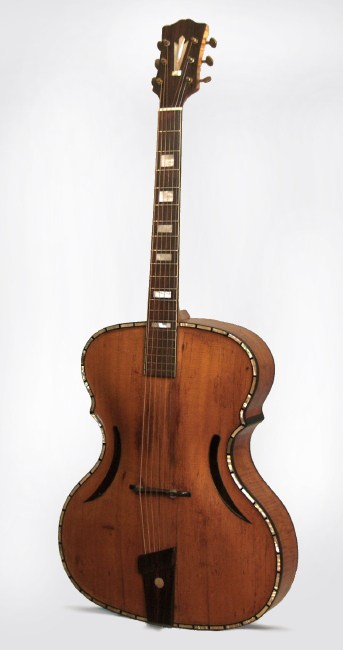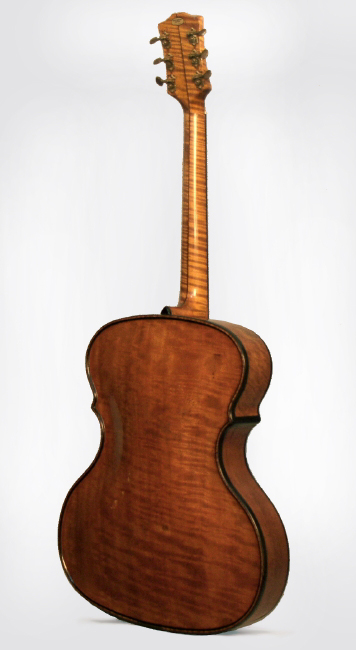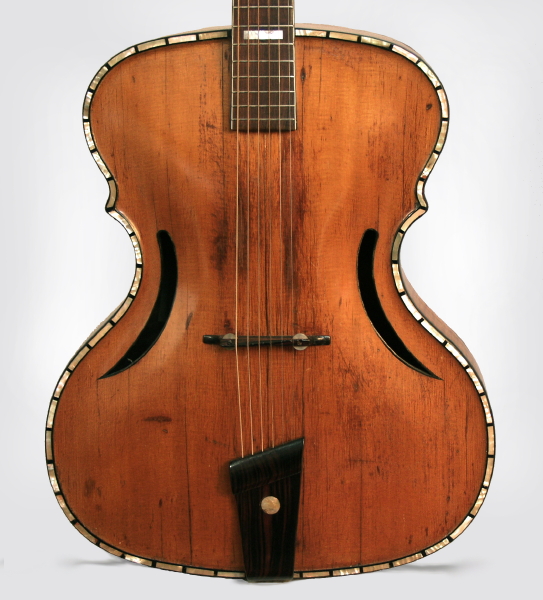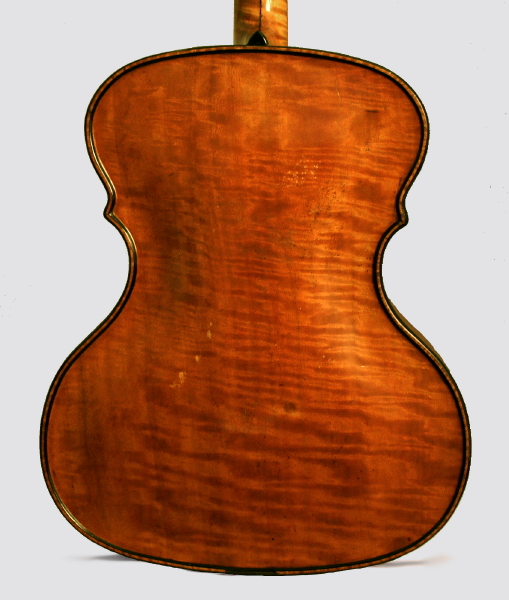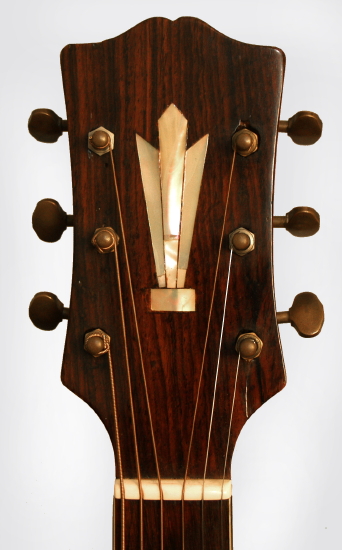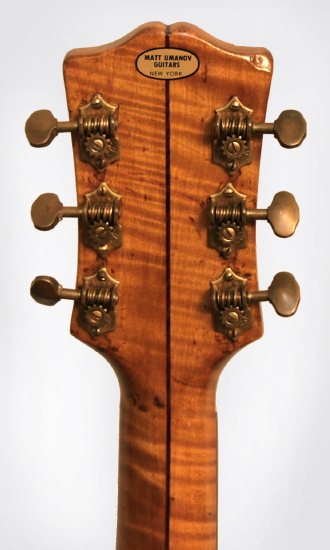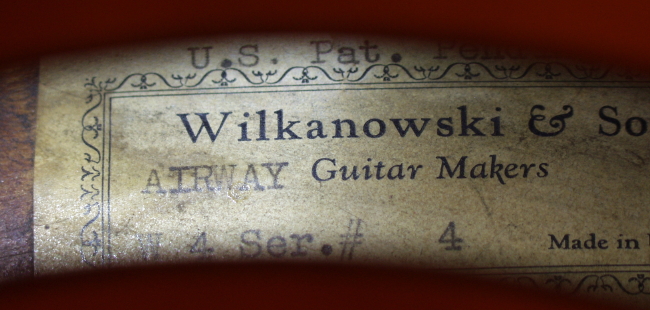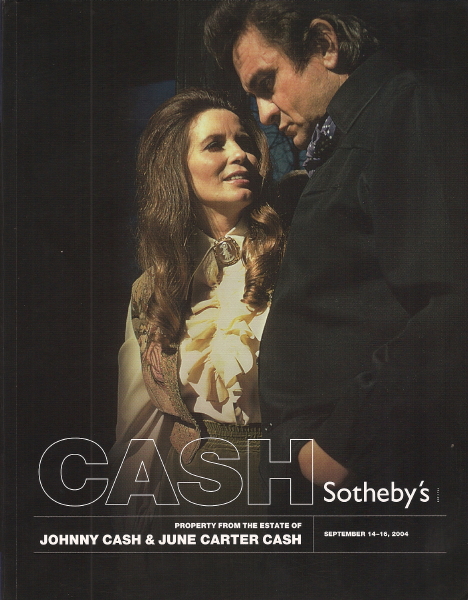Wilkanowski Airway W-4 Arch Top Acoustic Guitar Previously Owned by Johnny Cash, c. 1940
This item has been sold.
Item # 4172
Prices subject to change without notice.
Wilkanowski Airway W-4 Model Arch Top Acoustic Guitar, c. 1940, made in Brooklyn, NY, amber varnish finish, lombardy poplar back and sides, spruce top; curly maple neck with rosewood fingerboard.
This Wilkanowski Airway is one of the most interesting and unusual American guitars ever created, and a true (if eccentric) classic of the 1930's-40's arch-top era. The guitar was also for many years in the collection of one of 20th century America's greatest musical icons, Johnny Cash. Cash received the Wilkanowski guitar as a gift from his wife, June Carter Cash, in the 1980's and kept it until his death, after which it was sold at auction along with many items from the Cash estate in September 2004.
This guitar was also an early "GUITAR WORLD" centerfold in the early 1980's, in the formative days of vintage guitar obsession when Wilkanowski instruments were little known. This is truly a unique piece of guitar Americana both in origin and provenance, as well as a wonderful and totally distinctive playing instrument.
The detailed history of this maker is fairly obscure, but some details are known. Willi Wilkanowski was a well-known Brooklyn violin builder who, beginning around 1937, began crafting a very limited number of these striking guitars. No paper or catalog references to Wilkanowski guitars have surfaced and they were almost certainly offered only locally for sale in the New York area. While the guitar superficially resembles a small cello with a six-string neck, all the forms and design elements are unique. Only a handful of Wilkanowski guitars are known to exist, and no two appear exactly alike.
Wilkanowski was born in Poland in 1886, and was a full-fledged violin maker by the age of 17. After coming to the United States in the early 20th century, he built violins for the Ditson Company of Boston and New York, and then for the Fred Gretsch Company in Brooklyn. A 1940 Gretsch Jobber Catalog offers Wilkanowski "Artist Model" violins priced from $50-$150 described as "his own personal work…no other hand touches them".
While some sources claim Wilkanowski worked in Boston during the 1920's, he was listed as a violin maker and seller in Brooklyn in 1933, and anecdotal evidence suggests that the shop was at that location well before then. The 1942 book "KNOWN VIOLIN MAKERS" by John H. Fairfield estimates his production to that point as being 5000 violins and 100 violas, which would be prodigious for an individual or even a small workshop. At some point in the late 1930's, Wilkanowski became interested in the guitar and from his violinmaker's perspective approached the design in a most unorthodox way.
Wilkanowski's guitars all seem to date from between 1937 and 1941, although not all bear labels and/or dates. This particular guitar is labeled "Wilkanowski and Son Guitar Makers, Airway W-4 serial number 4". It is not dated but is in the later style, with particularly fancy pearl body trim which may have been the defining "W-4" style characteristic. Only guitars are encountered labeled "Wilkanowski and Son", not violins, so it is likely that at least one of his sons was involved in their design or construction. Most of the guitars carry no serial number, so the #4 seen here is not an indication that this is the fourth one built, although it may well have been the #4 in the "Airway" series, as that name did not appear on earlier examples.
Wilkanowski's family did not continue his instrument building after the father's death in 1954. It is possible that the guitar business was intended to be a separate entity perhaps run by his son or sons, but either it did not prosper or may have been discontinued due to the upheavals of the Second World War.
Wilkanowski guitars are nearly all built to the same basic shape and size, but some of the many variations include headstock shape, presence of a logo, fingerboard inlay, top ornamentation, soundhole shape, types of tuners and hardware, and exact body style and width. Later guitars like this one usually carry the name "AIRWAY" and/or a stylized letter "W" on the headstock, which this one does not.
Wilkanowski's guitars go through a rapid evolution of features in a short time, typical with handmade instruments, but whether these resulted from customer input or the builder's whims is unknown. The published 1942 estimates list 30 guitars as having been made, selling for $400 each, and no evidence suggests any were built after that. Whether Wilkanowski examined contemporary guitars from Gibson or his fellow New York builders Epiphone and D'Angelico is unknown; he must have been aware of these carved top instruments and gotten some general ideas from them. Certainly the quoted price reflects that he felt his instruments were the equal of an Emperor, Super 400, or D'Angelico New Yorker! It is also unknown as to whether he had any input into or was influenced by Gretch's Synchromatic line, which was being designed and launched around 1939. He obviously had extensive business dealings with Gretsch at the time.
This particular Wilkanowski guitar is both visually fabulous and a beautiful playing and sounding instrument. The body is in the standard Wilkanowski pattern, with cello-like points where the upper bout slopes down towards the waist. The dark-bound soundholes are the type used on later Wilkanowski instruments: a swooping "cat's-eye" design similar to the contemporary Gretsch Synchromatic style, but curving inward rather than outward. The fancy large-block pearl around the edge is only seen on these later Airways.
The grain on the back is extremely flamey, with an almost 3-D quality. The flame maple neck is unusual, with a very Gibson-like headstock shape seen on no other Wilkanowski. The tuners are period individual Grover "Sta-Tite" type, but appear to have been changed several times. The celluloid bound rosewood fingerboard has block inlay, and is stylistically unlike other Wilkanowski fingerboards…it appears possibly bought in, perhaps from a Chicago jobber.
The rosewood-faced headstock has a very deco pearl block inlay pattern but no logo. The rosewood tailpiece (with an unusual pearl dot inlay) is the type used only on later Wilkanowskis; he was the only archtop maker of the 1940's to use a wooden tailpiece, an idea popular with contemporary builders. The delicate carved bridge has small adjustment wheels and an internal cutout in the base. There is no pickguard; it appears to have been removed early on judging by the amount of top wear. The sound of this guitar is powerfully well -rounded and quite loud, and it projects extremely well.
We are most pleased to offer this guitar for sale from its original home of Brooklyn, NY, where Wilkanowski built these instruments. It has seen a great deal of use over the last 60+ years but is a spectacular example of 20th century guitar craft, and as the former property of Johnny Cash has been owned and played by a true icon of American music. Lesser guitars sold at auction from the Cash estate realized prices in excess of the asking price of this most unique piece.
Overall length is 41 7/8 in. (106.4 cm.), 17 3/16 in. (43.7 cm.) wide at lower bout, and 3 3/8 in. (8.6 cm.) in depth, measured at side of rim. Scale length is 25 1/4 in. (641 mm.). Width of nut is 1 11/16 in. (43 mm.).
Considerable finish wear, especially to top. Small patch on upper bass bout. Neck oversprayed, heel crack has been repaired, and there is evidence of several tuner mountings although original-style period Grovers have been fitted for the last 25 or so years. This is a well-used but great playing guitar, apart from all its historic significance. Very Good + Condition.
This Wilkanowski Airway is one of the most interesting and unusual American guitars ever created, and a true (if eccentric) classic of the 1930's-40's arch-top era. The guitar was also for many years in the collection of one of 20th century America's greatest musical icons, Johnny Cash. Cash received the Wilkanowski guitar as a gift from his wife, June Carter Cash, in the 1980's and kept it until his death, after which it was sold at auction along with many items from the Cash estate in September 2004.
This guitar was also an early "GUITAR WORLD" centerfold in the early 1980's, in the formative days of vintage guitar obsession when Wilkanowski instruments were little known. This is truly a unique piece of guitar Americana both in origin and provenance, as well as a wonderful and totally distinctive playing instrument.
The detailed history of this maker is fairly obscure, but some details are known. Willi Wilkanowski was a well-known Brooklyn violin builder who, beginning around 1937, began crafting a very limited number of these striking guitars. No paper or catalog references to Wilkanowski guitars have surfaced and they were almost certainly offered only locally for sale in the New York area. While the guitar superficially resembles a small cello with a six-string neck, all the forms and design elements are unique. Only a handful of Wilkanowski guitars are known to exist, and no two appear exactly alike.
Wilkanowski was born in Poland in 1886, and was a full-fledged violin maker by the age of 17. After coming to the United States in the early 20th century, he built violins for the Ditson Company of Boston and New York, and then for the Fred Gretsch Company in Brooklyn. A 1940 Gretsch Jobber Catalog offers Wilkanowski "Artist Model" violins priced from $50-$150 described as "his own personal work…no other hand touches them".
While some sources claim Wilkanowski worked in Boston during the 1920's, he was listed as a violin maker and seller in Brooklyn in 1933, and anecdotal evidence suggests that the shop was at that location well before then. The 1942 book "KNOWN VIOLIN MAKERS" by John H. Fairfield estimates his production to that point as being 5000 violins and 100 violas, which would be prodigious for an individual or even a small workshop. At some point in the late 1930's, Wilkanowski became interested in the guitar and from his violinmaker's perspective approached the design in a most unorthodox way.
Wilkanowski's guitars all seem to date from between 1937 and 1941, although not all bear labels and/or dates. This particular guitar is labeled "Wilkanowski and Son Guitar Makers, Airway W-4 serial number 4". It is not dated but is in the later style, with particularly fancy pearl body trim which may have been the defining "W-4" style characteristic. Only guitars are encountered labeled "Wilkanowski and Son", not violins, so it is likely that at least one of his sons was involved in their design or construction. Most of the guitars carry no serial number, so the #4 seen here is not an indication that this is the fourth one built, although it may well have been the #4 in the "Airway" series, as that name did not appear on earlier examples.
Wilkanowski's family did not continue his instrument building after the father's death in 1954. It is possible that the guitar business was intended to be a separate entity perhaps run by his son or sons, but either it did not prosper or may have been discontinued due to the upheavals of the Second World War.
Wilkanowski guitars are nearly all built to the same basic shape and size, but some of the many variations include headstock shape, presence of a logo, fingerboard inlay, top ornamentation, soundhole shape, types of tuners and hardware, and exact body style and width. Later guitars like this one usually carry the name "AIRWAY" and/or a stylized letter "W" on the headstock, which this one does not.
Wilkanowski's guitars go through a rapid evolution of features in a short time, typical with handmade instruments, but whether these resulted from customer input or the builder's whims is unknown. The published 1942 estimates list 30 guitars as having been made, selling for $400 each, and no evidence suggests any were built after that. Whether Wilkanowski examined contemporary guitars from Gibson or his fellow New York builders Epiphone and D'Angelico is unknown; he must have been aware of these carved top instruments and gotten some general ideas from them. Certainly the quoted price reflects that he felt his instruments were the equal of an Emperor, Super 400, or D'Angelico New Yorker! It is also unknown as to whether he had any input into or was influenced by Gretch's Synchromatic line, which was being designed and launched around 1939. He obviously had extensive business dealings with Gretsch at the time.
This particular Wilkanowski guitar is both visually fabulous and a beautiful playing and sounding instrument. The body is in the standard Wilkanowski pattern, with cello-like points where the upper bout slopes down towards the waist. The dark-bound soundholes are the type used on later Wilkanowski instruments: a swooping "cat's-eye" design similar to the contemporary Gretsch Synchromatic style, but curving inward rather than outward. The fancy large-block pearl around the edge is only seen on these later Airways.
The grain on the back is extremely flamey, with an almost 3-D quality. The flame maple neck is unusual, with a very Gibson-like headstock shape seen on no other Wilkanowski. The tuners are period individual Grover "Sta-Tite" type, but appear to have been changed several times. The celluloid bound rosewood fingerboard has block inlay, and is stylistically unlike other Wilkanowski fingerboards…it appears possibly bought in, perhaps from a Chicago jobber.
The rosewood-faced headstock has a very deco pearl block inlay pattern but no logo. The rosewood tailpiece (with an unusual pearl dot inlay) is the type used only on later Wilkanowskis; he was the only archtop maker of the 1940's to use a wooden tailpiece, an idea popular with contemporary builders. The delicate carved bridge has small adjustment wheels and an internal cutout in the base. There is no pickguard; it appears to have been removed early on judging by the amount of top wear. The sound of this guitar is powerfully well -rounded and quite loud, and it projects extremely well.
We are most pleased to offer this guitar for sale from its original home of Brooklyn, NY, where Wilkanowski built these instruments. It has seen a great deal of use over the last 60+ years but is a spectacular example of 20th century guitar craft, and as the former property of Johnny Cash has been owned and played by a true icon of American music. Lesser guitars sold at auction from the Cash estate realized prices in excess of the asking price of this most unique piece.
Overall length is 41 7/8 in. (106.4 cm.), 17 3/16 in. (43.7 cm.) wide at lower bout, and 3 3/8 in. (8.6 cm.) in depth, measured at side of rim. Scale length is 25 1/4 in. (641 mm.). Width of nut is 1 11/16 in. (43 mm.).
Considerable finish wear, especially to top. Small patch on upper bass bout. Neck oversprayed, heel crack has been repaired, and there is evidence of several tuner mountings although original-style period Grovers have been fitted for the last 25 or so years. This is a well-used but great playing guitar, apart from all its historic significance. Very Good + Condition.
